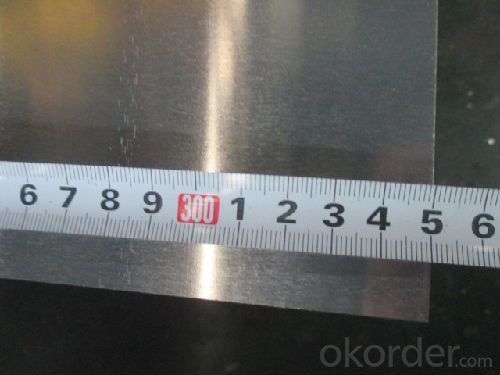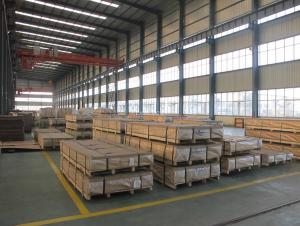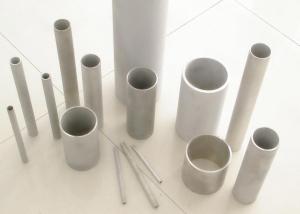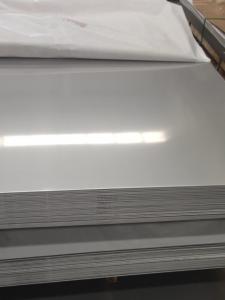Stainless Steel Cold Rolled Sheet And Plate Stocsk
- Loading Port:
- Tianjin
- Payment Terms:
- TT or LC
- Min Order Qty:
- 7 m.t.
- Supply Capability:
- 5000 m.t./month
OKorder Service Pledge
OKorder Financial Service
You Might Also Like
1.Structure of Product Description
Cold rolled aluminum sheet and also the other grades are all best-selling now,
is widely used in the field of construction field and decoration field, etc.
There are many different grades, such as: 1000 series, 2000 series, 3000 series, 5052,5754,5083,6061,6063,8011, etc.
The temper is include H14, H22, H24, H44,H112,H114,etc.
2. Main features of the product
a.Competitive price
b.Frist-Class Service.
c. Shortest service.
3. Image.


4. Product detailed sizes:
1000mm*2000mm, 1219mm*2438mm,2440mm, 1250mm*2500mm,1500mm*3000mm, etc.
5. FAQ:
What is the quality standard?
---Usually our standard is GB3880-2006 or others.
What is the width range?
---It is from 1000mm to 2500mm, etc.
---Normally it is around 9000 tons totally.
Where is your client from?
---Normally it is from Japan, USA, canada,turkey,ETC.
What is your mainly products?
---Normally they are aluminum sheet, checkered sheet,
big 5 bar checkered sheet and mirror finshe shet mirror finish aluminium sheet, aluminum casting coil, etc.
- Q: Are stainless steel sheets fire-resistant?
- Yes, stainless steel sheets are fire-resistant.
- Q: What are the different surface patterns available for stainless steel sheets?
- Some of the different surface patterns available for stainless steel sheets include brushed, mirror, embossed, and patterned.
- Q: What are the different types of stainless steel sheet surface patterns for architectural purposes?
- There are several types of stainless steel sheet surface patterns commonly used for architectural purposes. Some of these patterns include brushed, mirror, embossed, bead blasted, and patterned. Each pattern offers a unique aesthetic appeal and can be chosen based on the specific requirements and design preferences of a project.
- Q: How do you prevent galling on stainless steel sheets?
- To prevent galling on stainless steel sheets, it is important to use lubricants or anti-seize compounds during the manufacturing or assembly process. This helps reduce friction and surface adhesion, minimizing the risk of galling. Additionally, using proper cutting tools and techniques, such as slow speeds and low feed rates, can also help prevent galling.
- Q: Are stainless steel sheets suitable for roofing?
- Yes, stainless steel sheets are suitable for roofing. They have excellent durability, corrosion resistance, and can withstand extreme weather conditions. Additionally, their sleek appearance adds aesthetic value to any building.
- Q: Are stainless steel sheets suitable for laboratory equipment or instruments?
- Yes, stainless steel sheets are highly suitable for laboratory equipment or instruments. Stainless steel is known for its excellent corrosion resistance, durability, and high strength, making it an ideal choice for laboratory applications. It is resistant to chemicals, heat, and staining, which ensures the longevity and reliability of the equipment. Additionally, stainless steel is easy to clean and maintain, meeting the strict hygiene standards required in laboratories.
- Q: Can stainless steel sheets be used for pharmaceutical storage cabinets?
- Indeed, pharmaceutical storage cabinets can make use of stainless steel sheets. Stainless steel possesses a remarkable resistance to corrosion, rendering it an excellent choice of material for pharmaceutical storage due to the necessity for sterile and hygienic environments. Moreover, stainless steel proves effortless to cleanse and uphold, guaranteeing the absence of contaminants within the storage cabinets. Furthermore, stainless steel demonstrates durability and longevity, thereby offering a dependable and secure storage solution for pharmaceuticals.
- Q: What are the different types of stainless steel sheet finishes for industrial applications?
- In industrial applications, various types of stainless steel sheet finishes are commonly utilized. These finishes serve different purposes in terms of durability, resistance to corrosion, and aesthetics. 1. No. 1 Finish: This finish is achieved through a process of hot rolling, annealing, and pickling, resulting in a rough and dull surface. It finds its application in structural components or areas where a smooth surface is not essential. 2. No. 2B Finish: Achieved by cold rolling, annealing, and pickling, this finish offers a moderately reflective and smooth surface. It is commonly used in applications where both corrosion resistance and appearance are important, such as kitchen appliances, architectural components, and food processing equipment. 3. No. 4 Finish: This finish is obtained by polishing with abrasive belts or brushes, resulting in a matte appearance. It is often employed in applications where a decorative finish is desired, such as furniture, elevator panels, and signage. 4. No. 8 Finish: Also known as a mirror finish, this is the most reflective finish available for stainless steel sheets. It is achieved by progressively polishing with finer abrasives until a highly reflective surface is obtained. This finish is commonly used for architectural accents, automotive trims, and decorative items that require a high level of reflectivity and a pleasing appearance. 5. BA Finish: This finish is achieved through annealing in a controlled atmosphere furnace, resulting in a highly reflective and smooth surface. It is commonly used in applications where a mirror-like finish is desired, such as decorative items, reflectors, and light fixtures. These are just a few examples of the various stainless steel sheet finishes commonly employed in industrial applications. Each finish possesses unique properties and is suitable for different purposes. Therefore, it is crucial to carefully consider the specific requirements of the application when selecting a finish.
- Q: Are stainless steel sheets scratch-resistant?
- Yes, stainless steel sheets are scratch-resistant due to their high durability and resistance to wear and tear.
- Q: What is the tensile modulus of stainless steel sheets?
- The tensile modulus of stainless steel sheets typically ranges from 180 to 200 GPa (Gigapascals).
Send your message to us
Stainless Steel Cold Rolled Sheet And Plate Stocsk
- Loading Port:
- Tianjin
- Payment Terms:
- TT or LC
- Min Order Qty:
- 7 m.t.
- Supply Capability:
- 5000 m.t./month
OKorder Service Pledge
OKorder Financial Service
Similar products
Hot products
Hot Searches
Related keywords




























